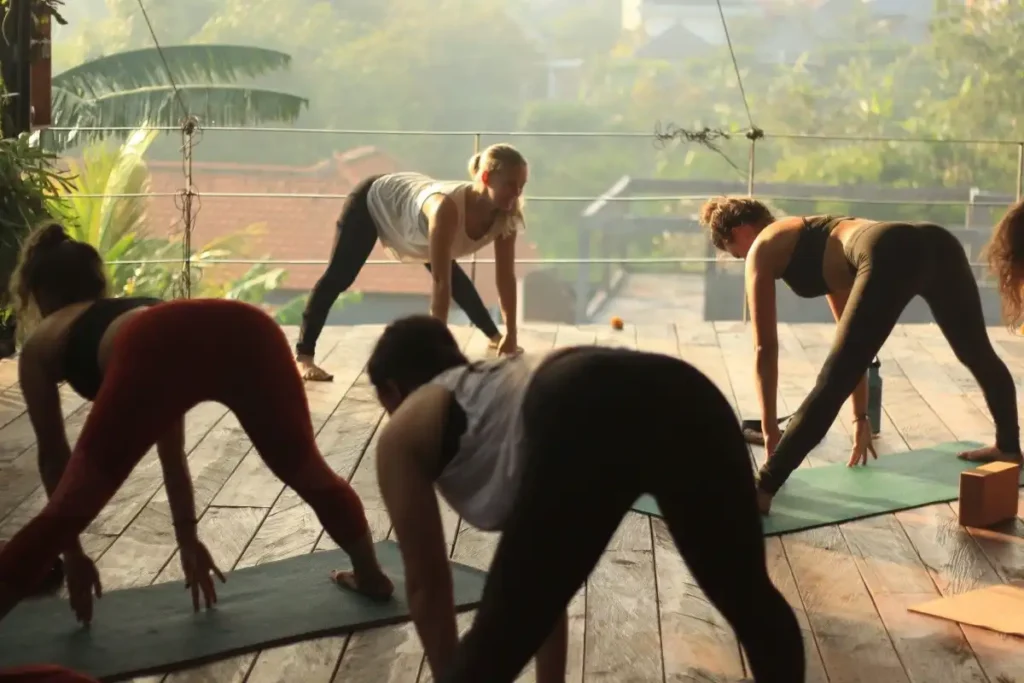The global yoga community is undergoing a dynamic transformation as hybrid yoga classes—which merge physical studio instruction with virtual participation—gain widespread popularity in 2024. This blended model, born out of necessity during the pandemic, has now evolved into a permanent fixture in the wellness industry, bridging convenience with community and reshaping how yoga is taught and practiced worldwide.
As yoga continues its ascent as a mainstream wellness practice across age groups, cultures, and countries, instructors and studios have begun integrating digital tools into their physical sessions. From live-streaming studio classes to offering real-time feedback to remote participants, hybrid formats are being embraced for their flexibility, inclusivity, and ability to accommodate diverse lifestyles.
From Temporary Shift to Lasting Innovation
What began as a stopgap measure during COVID-19 lockdowns has become a robust, adaptive system. In the early days of the pandemic, yoga instructors rapidly pivoted to platforms like Zoom, Instagram Live, and YouTube to maintain contact with students. But what was once a temporary necessity has now proven to be a viable, scalable model.
Post-pandemic, many practitioners have opted to maintain this flexible structure. Hybrid classes allow them to attend sessions whether they’re at home, traveling, or unable to commute. For teachers and studios, it has unlocked new levels of engagement and reach—connecting with students across countries and time zones.
According to the Global Yoga Alliance’s 2024 survey, over 60% of certified yoga instructors now offer some form of hybrid teaching. In North America, Western Europe, and Southeast Asia, this figure exceeds 70%, with many yoga schools designing their spaces to include cameras, microphones, and virtual streaming zones.

Bridging Accessibility and Authenticity
Hybrid classes have proven especially beneficial for individuals with limited access to local yoga studios. Those living in remote or rural regions, people with mobility issues, busy professionals, and parents with caregiving responsibilities now have more consistent access to high-quality instruction.
Virtual participation doesn’t just offer convenience—it levels the playing field. Students who previously faced geographic, financial, or social barriers can now join sessions led by world-renowned instructors without leaving their homes. At the same time, those seeking hands-on guidance, physical presence, or the ambiance of a group class can opt for the in-person version.
This dual approach accommodates different comfort levels, learning styles, and wellness needs. It allows yoga to be inclusive while maintaining the depth and connection that traditional in-studio classes offer.
Technological Enhancements Elevate Experience
The hybrid model wouldn’t be sustainable without a surge in user-friendly, high-quality tech. Innovations such as 360-degree cameras, wireless microphones, wearable sensors, and smart yoga mats have made virtual sessions far more immersive and effective.
Platforms like Zoom for Wellness, Mindbody, Namastream, and WellnessLiving now provide dedicated features for hybrid class management, including real-time attendance tracking, screen layout optimization, interactive chat functions, and live recording integration.
Instructors use multi-angle cameras to demonstrate poses from various perspectives, while advanced audio setups ensure clear instruction and ambient music—creating an experience that feels both personal and studio-like for virtual attendees.
Some hybrid platforms also allow two-way video interaction, where instructors can view and correct student postures in real time—enhancing the safety and personalization of the online experience.
New Business Models Emerge for Instructors
The hybrid format has ushered in fresh business opportunities for yoga instructors and studios. Teachers can now build global student communities, running morning sessions in their time zones and evening classes for audiences across the world.
Subscription-based models, tiered memberships, and digital content libraries have become key revenue drivers. Studios offer recorded sessions, exclusive tutorials, and guided meditations on-demand, generating passive income even outside live classes.
This hybrid approach also reduces studio overhead. Instructors no longer need to rely solely on foot traffic to sustain operations. By offering both virtual and physical participation, they can increase class sizes, minimize cancellations, and expand brand visibility across digital channels.
Student Perspectives: Choice, Comfort, and Continuity
From a student’s perspective, the appeal of hybrid classes lies in choice. A practitioner may attend a Monday in-person class for alignment corrections, join Wednesday’s session virtually due to a tight work schedule, and replay Friday’s class on the weekend.
For frequent travelers and digital nomads, hybrid options ensure consistency in practice, no matter the location. Likewise, students recovering from injuries or illness can continue engaging without physical strain.
Testimonials from hybrid yoga participants point to enhanced discipline and motivation. Many feel more connected to their instructors through multiple touchpoints, whether via virtual check-ins, community forums, or post-class emails.
Corporate Wellness Programs Adopt Hybrid Yoga
Hybrid yoga has also carved out a growing role in corporate wellness programs. Companies now offer employees access to both in-office yoga sessions and virtual options they can join remotely. This ensures participation regardless of work location or travel commitments.
Hybrid wellness offerings are particularly prevalent in tech firms, remote-first startups, and global organizations where employees operate across multiple time zones. Regular yoga sessions—delivered in hybrid formats—have been linked to improved employee focus, lower stress levels, and stronger team morale.
Preserving Community in a Hybrid Era
Critics of digital wellness once feared that yoga’s shift online would erode the sense of community central to the practice. However, hybrid classes have sparked new forms of social engagement.
Many instructors foster community through virtual circles, online retreats, WhatsApp groups, and monthly wellness challenges. These features encourage connection, accountability, and dialogue beyond the mat.
Moreover, hybrid events such as global meditation days, yoga-thons, and charity livestreams now bring thousands of participants together across continents—proving that community in yoga is no longer confined to physical spaces.
Challenges in Hybrid Implementation
Despite its success, hybrid yoga presents logistical and quality-control challenges. Instructors must juggle the needs of two audiences simultaneously: offering tactile corrections in the room while addressing virtual queries and ensuring visibility on screen.
Studios also face tech maintenance demands—ensuring strong internet connections, battery life, and audio-video synchronization.
To mitigate these issues, many instructors have begun hiring virtual assistants or co-teachers. These helpers manage tech setups, monitor online participation, and troubleshoot in real-time—allowing the lead teacher to focus fully on instruction.
Additionally, professional development courses now train yoga teachers in hybrid class management, online safety, camera etiquette, and digital engagement strategies.
Future of Hybrid Yoga: Evolving, Expanding, Enduring
Looking ahead, hybrid yoga is expected to grow even more sophisticated. Innovations in augmented reality (AR) and virtual reality (VR) will enable participants to join holographic group sessions or practice in immersive 3D environments.
Wearable devices will soon transmit biometric data to instructors, allowing them to adjust intensity and pacing based on real-time heart rate, posture, or oxygen levels.
Moreover, hybrid models are likely to expand into niche yoga areas—such as trauma-sensitive yoga, prenatal classes, yoga therapy, and youth programs—reaching vulnerable populations who may not access in-person support.
In essence, hybrid yoga reflects a deeper evolution in wellness—one that honors tradition while embracing innovation. It allows the practice to meet people where they are, physically and emotionally, while preserving its core values of mindfulness, balance, and community.
As the boundaries between physical and digital continue to blur, hybrid yoga is no longer a backup option—it is the future of practice.





